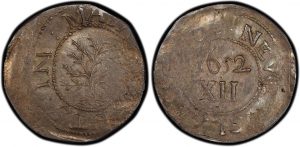The 1652 Shilling Oak Tree
Posted onIn the early 1600s, the owners of the Massachusetts Bay Company founded the Massachusetts Bay Colony. The settlement, located around Massachusetts bay, was in fact the second attempt at a settlement by the company.

Ultimately, the attempt was successful, with about 20,000 inhabitants who migrated to the area around the 1630s. The colony found success in trading with England, Mexico, and the West Indies. Initially, barter was an effective form of exchange. This later gave rise to the use of English pounds, Spanish “pieces of eight”, and wampum. However, by the early 1650s, a currency shortage became a problem.
The colonists decided to authorize silversmith John Hull to create new coins. More than just a silversmith, Hull was a merchant, politician, and military officer. He is also remembered today as an early benefactor of Harvard University. The authorization gave him the right to re-mint foreign silver currency in shilling, sixpence, and three-pence denominations.
Hull chose simple designs for the pieces, spending only five months minting the coins. He stamped the obverse with “NE” for New England. On the reverse, he stamped them with one of three Roman numerals, “III”, “VI” or “XII.” The central image of a willow tree eventually changed to an oak tree on pieces minted starting around 1660. The final version, minted between 1667 and 1682, features a pine tree and became the most popular of the set. The reason for its popularity was likely due to the fact that the image signified the export of pine timber used to construct the mainmasts in British warships.
The coins, however, would eventually become a point of contention between the colonists and England. Hull and others were, according to the English, in violation of the Navigation Acts which was intended to regulate the way trade was conducted within the colonial empire.
Today, the imperfections of the pieces are a perfect representation of the difficult and rugged conditions in which the colonists lived, with many sleeping in dugouts or wigwams. The roughness of the willow tree version is sometimes evident in what appears to be double or triple striking likely caused by cylindrical dies which had a tendency to rotate. In time, prismoidal dies took their place. These dies, which had four, six, or eight sides, could be clamped ensuring that the die would not rotate. The pine tree shillings remain the most commonly known of the coins due mainly to the fact that they were produced in the largest quantity and that they were the latest version minted.
Eventually, Hull went on to become Boston’s treasurer in 1658 holding the office for almost a decade. He later became treasurer of the Massachusetts Bay Colony from 1676 to 1680. In 1681, Hull became instrumental in acquiring the Province of Maine for the Massachusetts Bay Colony. Unfortunately, shortly after in 1683, Hull died. Today, Hull Street in Boston is named after him and his coins remain a sought-after piece of American history.
Want to read more? Subscribe to the Blanchard Newsletter and get our tales from the vault, our favorite stories from around the world, and the latest tangible assets news delivered to your inbox weekly.







